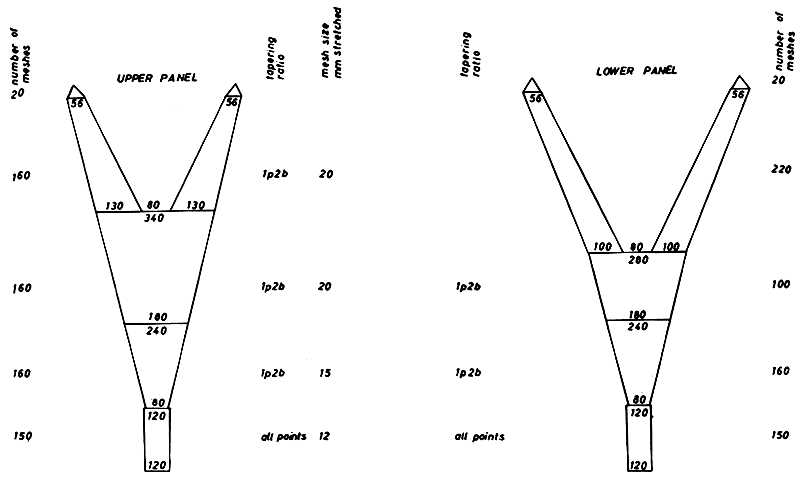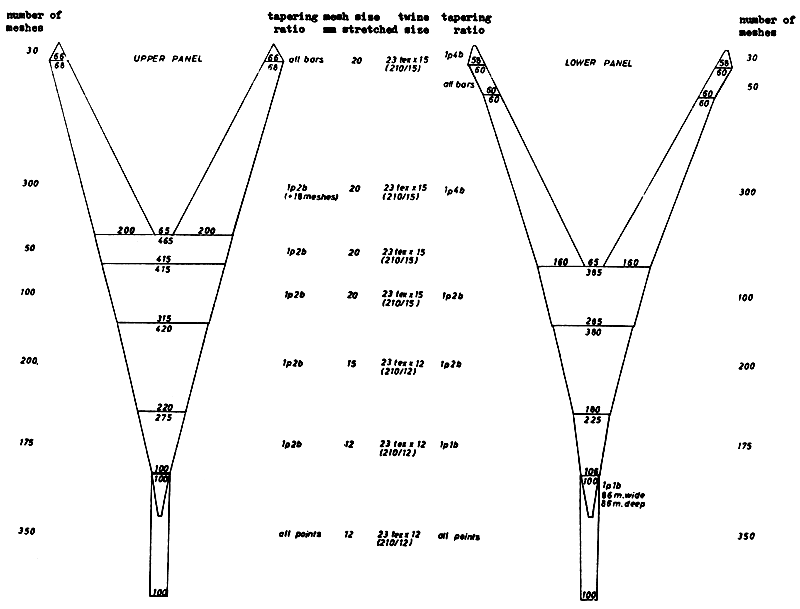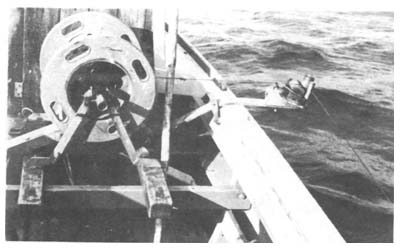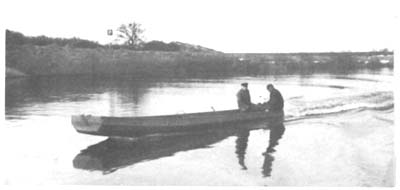by
Dr. R. Steinberg
Institut für Fangtechnik, Bundesforschungsanstalt für Fischerei
Hamburg, Federal Republic of Germany
Because of the increasing scarcity of labour it is necessary to introduce mechanisation into freshwater fishery operations. Another way to reduce manpower would be to introduce new fishing methods, which would not require as much labour. Such methods should make it possible to catch fish of a special kind in the desired quantity at the proper time. In this connection the tourist season in summer is the period of importance to many fisheries. During the season, therefore, those fish species which are most remunerative must be fished intensively. In German freshwater fisheries this is usually the eel.
The Institute for fishing techniques, accordingly, has devoted much time since 1964 in collaboration with various freshwater fishery interests to increase the amount of the eel catch by the use of trawl nets in fisheries. From the beginning all efforts were concentrated on the two-boat bottom trawl, as under the special conditions obtaining in freshwater fisheries, this method has several advantages compared with the one-boat method. In freshwater fisheries only small vessels with relatively low-powered motors are usually available. However, since in the two-boat method two motors are used instead of one, sufficient power is available. The horizontal spreading of the net is effected by the two vessels sailing abreast at a certain distance from each other. The use of otterboards is, therefore, not necessary and so the considerable towing resistance of the otterboards is eliminated. Thus, with the two-boat method, relatively small boats can tow relatively large trawls and experience has shown that this is very important in eel fishing if best results are to be obtained.
The first practical tests were carried out in 1964 in the larger North German lakes. In the beginning a relatively small simple net was used (Fig. 1). This gear could be towed by the available 20 hp-boats with a towing speed of up to 3 knots. The results however, were not very satisfactory, but valuable experience was obtained on the handling of the nets and about the most suitable towing speed.
On the basis of these experiences, a large modified trawl was built. This gear was further modified by lengthening the wings by one third. The type of net developed at this time is still used at present in various freshwater fisheries and in further tests being carried out by the Institute (Fig.2). The rig and the mode of operation employed is the same as that used in the Baltic Cutter Fishery (Fig. 3). A leg length of 6 Fd has been selected. The length of the middle legs plays a significant part in the efficiency of operation of this net. By reducing the length of these legs, a higher net opening is provided and by increasing the length of the legs a net opening of smaller height but greater width is obtained and this larger width is of particular advantage when used in fishing for eels. The length of the bridle is an important consideration especially during the shooting and hauling of the net. The bridles should not be too short for the operation of handing over one wing of the net from one boat to the other. Careful attention has also to be paid to the size of the front weights employed as they have to be sufficient to keep the fishing gear at the bottom. If the weight is not heavy enough the net will rise and this would be a decided disadvantage especially in eel fishing, even though occasionally eels may be caught with trawls in mid-water.
When fishing on soft ground it is recommended that an extra, somewhat thicker rope be fitted in loops to the foot rope of the net. The foot rope weights are mounted on this rope and this protects the net when it touches the ground as it does much to prevent the foot rope cutting into the ground.
When fishing in greater depths of water, it is recommended to use relatively thin wires with a diameter of about 2 – 3 mm as towing warps which can be handled with the aid of a small hand winch (Fig. 4). Otherwise ropes, with a diameter of about 12 mm or more, which can be shot and hauled by hand, are necessary.
The shooting and the hauling of a two-boat bottom trawl is best done in the following manner: First the net is shot from one boat as far as the danleno. Then the boat is turned into the desired towing direction. The second vessel then draws alongside and takes over one bridle and fixes it to the towing warp. The towing warps of both vessels are then shot to a suitable length and at the same time both vessels take position about half the length of the towing warp apart. The length of the towing warps depends, of course, on the depth of water in which the fishing is carried out. At a water depth of only 2 – 3 m about 40 m of warps will be sufficient; at a depth of 10 m about 90 m is necessary and at about 20 m depth approximately 120 m of warp should be short. Otherwise, as observations with a netsonde have shown, the gear will rise from the ground. It is, in any event, better to use a long warp than a short one. A towing speed of 1 to 1–2 knots is suitable for eel fishing with a two boat bottom trawl as it is for other species of fish.
When hauling the gear both vessels stop. With begger boats it is better if they turn into the direction of the towing warps. These warps are hauled by hand-winches while the boats proceed at low speed. Smaller boats, on the other hand, can be drawn slowly back to the net while the warps are hauled by hand. Finally the one bridle is detached from the towing warp of one boat and handed over to the other boat, whereupon the net and the catch are hauled on board that boat.
For this type of fishing, only one man per boat is required, which means that large areas can be fished with a two-boat trawl with a crew of two only.
Initially, two-boat trawl were fished in large lakes only. Subsequently they were also employed under much more difficult conditions as for example in artificial lakes. This gear can also be employed in rivers if the current and the traffic are not too strong. The nature of the bottom is of secondary importance as it does not matter whether the ground is hard or soft. Variations in water depths in the course of a haul do not hinder fishing operations with two-boat trawls (Fig. 5). It is, however, important that there are no obstacles in the path of the net, such as large stones or butts of sticks.
The requirements as regards the type of boat employed are not very great. Seaworthy boats only should be used on larger waters; otherwise, all that is necessary is that the boats have sufficient space to handle the gear.
The engine power required depends mainly on the depth of water in which fishing shall take place. The best type is a slow running 20 hp-Diesel motor driving a propeller which is suitable for towing (Fig. 6). This would provide sufficient towing speed at depths down to 30 m, if the net already described, complete with long wings, was used. In shallow waters, not exceeding 10 m, outboard motors of at least 15 hp would be sufficient (Fig. 7). However, as outboard motors usually have a high revolution per minute, they do not have the towing power of a Diesel motor with the same hp. They are furthermore not as long-lasting as is the Diesel engine.
The yield by the two-boat bottom trawling method has been good in nearly all waters in which fishing has been carried out both in the initial experimental fishing and subsequently in the commercial fishing. The largest eel catches were almost exclusively made during the night. In a large lake in North Germany, 300 to 500 eels were frequently caught in one night alone. The total weight was 60 to 120 kg. The total towing time was usually between four to six hours per night. In addition to eels, 50 to 100 kg of perch and reach were also captured. Even under the difficult conditions of an artificial lake, which necessitated a towing time of approximately nine hours, about 1 300 eels weighing 350 kg were caught and in addition, almost 320 kg of perch and 55 kg of pike-perch were captured. It should, however, be borne in mind that in this artificial lake each haul could, on the average, last only 19 minutes due to the rough ground.
It is remarkable that the two-boat bottom trawl can be used successfully earlier in the year than can any other gear. In a lake in Sleswick-Holstein, on many occasions in the first half of April, several hundred eels per night were caught with the trawl net. It has, however, not yet been possible to use the gear common in eel fishing, like traps and angles, successfully, so early in the year.
From the account given it will be clear that the two-boat bottom trawl is a very profitable system to operate in freshwater for eel and other fish. However, the experience gained over several years has shown that the continuous use of this gear in freshwater is not to be recommended. Too frequent employment of the two-boat bottom trawl will result in a serious reduction in the stock of fish, and in addition, eel and other fish will tend to avoid those areas in which this gear is used. Therefore, the gear in question should only be used at large intervals. Then it should be possible to satisfy large demands by employing the two-bottom trawl for a short time only.
In conclusion it may be mentioned that it has been the experience in Eastern Germany that a combination of the trawl net fishery with electro-fishery can be very successful. Such a combination has not so far been necessary in fishing in Western Germany owing to the efficiency of the type of net used. Because of this fact, tests of this method have only recently been started by the Institute. The results will be published at a later date.
DISCUSSION:
| Deelder | - | It was essential that unrestricted trawling for eels should be prevented if the eel fisheries were to survive. Trawling had been practised in the Netherlands since 1500. First measures taken to prevent trawling were taken by Emperor Charles V in 1555 and in about 1600 trawling in inland waters was forbidden. In 1932 the Zuiderzee was closed and trawling was permitted in the IJsselmeer. Craft were primarly limited to sailing boats or boats with motors up to 20 hp. There was a week-end closed season and the open season was limited finally to four months per year. Fishermen employed various nefarious means to reduce the effective mesh sizes. Trawling had finally been forbidden in 1970. Trawling was expensive due to the cost of boats; production tended to be low with the result that there are now fewer fishermen and the survivors are no richer. Present IJssel lake production is about 10 kg per ha.elsewhere, with no trawling, production is 20 kg per ha and more. Trawling had an effect on the behaviour of eels. After a trawler has made a haul in a certain region, the fyke net catches were reduced for some time. All evidence pointed to eels being so frightened and otherwise badly affected by trawling that they went off food and sought refuge for long periods. In tagging experiments with market-size eels (using plastic arrow tag) which were caught in fyke nets and liberated after tagging in areas where there was no trawling, some eels were recaptured the same night and about 25 per cent were recaptured in two weeks. When the experiment was repeated with eels caught in trawls, about a month elapsed before a normal number of tagged eels were caught. IJsselmeer eels grow at a rate of 3 cm per year, in Veerse Meer at about 6 cm per year. In view of low growth rate, it is essential that the intensity of fishing be kept down. |
| v. Brandt | - | agreed that in the case of coastal waters and the IJsselmeer Deelder was, no doubt, correct to object to trawling. However, it was necessary in general, to make fishing methods as efficient as possible. In Germany, the fishery owner made a contract with the State and was solely responsible for the fishing. If only one man rents a lake, he should use the most efficient possible method of catching fish. This was legitimate in situations such as obtained in Germany where the fisherman was obliged to undertake the restocking of the waters fished by him to the extent specified by the Fishery Authority. |

Fig. 1 Structure of a small freshwater two-boat bottom trawl for eel.

Fig. 2 Two-boat bottom trawl for catching eel in freshwater.

Fig. 3 Schematic representation of the rigging for freshwater two-boat bottom trawls.
 |  | ||
| Fig. 4 | Haul winch for trawl fishery in freshwater. | Fig. 5 | Echogram of a haul in changing water depths. |
 |  | ||
| Fig. 6 | Seaworthy boat with 20 hp Diesel engine for trawl fishery in lakes. | Fig. 7 | Openboat driven by 15 hp outboard motor for trawl fishery in small and shallow waters. |